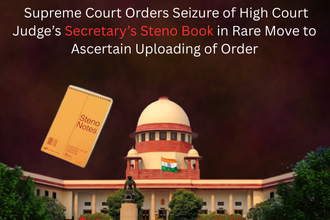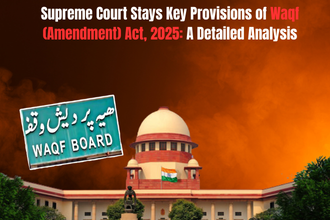In an unprecedented development, the Supreme Court of India has directed the seizure of a High Court judge’s secretary’s steno book to verify the exact timeline of when a judicial order was typed, corrected, and uploaded on the High Court website. The unusual direction came while hearing a Special Leave Petition (SLP) arising from an anticipatory bail matter before the Punjab and Haryana High Court.
The order has attracted widespread attention in legal and judicial circles, as it underscores the apex court’s concern over delays in uploading judicial orders and lack of accountability in the process.
Background of the Case
The case before the Supreme Court—Ajay Maini v. State of Haryana & Ors. | Diary No. 45855/2025—concerned the rejection of an anticipatory bail application by the Punjab and Haryana High Court. The High Court’s order was purportedly passed on July 31, 2025, but when the petitioner approached the Supreme Court on August 16, 2025, the order had still not been uploaded on the High Court’s website.
As a result, the petitioner filed the SLP without attaching a copy of the High Court’s order, arguing that the order was not available for public access.
Supreme Court’s Initial Concern
On August 20, 2025, the Supreme Court bench comprising Justice JK Maheshwari and Justice Vijay Bishnoi took note of the complaint and directed the Registrar General of the Punjab and Haryana High Court to file a report on why the order was not uploaded.
The Registrar General, in his report, stated that an explanation had been sought from the judge’s secretary. However, the secretary delayed his response and only replied after two days. This approach drew criticism from the Supreme Court, which observed that “immediate action in the matter to report at the earliest, was not taken.”
Key Observations of the Supreme Court
The Supreme Court highlighted several irregularities during its hearing:
- Delayed Response from Secretary – The judge’s secretary failed to specify when exactly the order was uploaded, only stating that the concerned judge had undergone medical treatment and surgery between August 1 and August 20, 2025.
- Order Uploaded After Supreme Court’s Intervention – The Court noted that the order was uploaded only after August 20, 2025, raising doubts about whether it was actually passed on July 31, 2025, as claimed.
- Possibility of Backdating the Order – The bench remarked:
“It appears that the order impugned was not passed on 31st July, 2025. In fact, it was passed after the order by this Court.”
This observation raised the serious possibility that the order may have been backdated, which could amount to judicial impropriety if proven true.
Rare Direction: Seizure of the Secretary’s Steno Book
In a rare and extraordinary move, the Supreme Court ordered the seizure of the steno book of the judge’s secretary. The Court directed that a discreet inquiry be conducted to ascertain the following:
- The exact date on which the order was typed.
- When corrections were made on the personal computer.
- When the order was finally uploaded on the High Court’s official website.
Additionally, the Court sought a report from the National Informatics Centre (NIC) to trace the digital record of typing and uploading activities related to the order. The Court ordered that this report must be submitted on affidavit, ensuring accountability in the process.
Interim Relief to the Petitioner
While ordering the inquiry, the Supreme Court also granted interim protection to the petitioner, directing that no coercive action be taken against him in connection with the FIR, provided that he fully cooperates with the investigation.
This relief was crucial for the petitioner, who had approached the Supreme Court due to the delay in accessing the High Court’s order.
Larger Context: Supreme Court’s Concern on Judicial Delays
This case comes on the heels of another significant judgment delivered by the Supreme Court just last week. A bench led by Justice Maheshwari expressed strong disapproval of inordinate delays by High Courts in pronouncing reserved judgments.
The Court had laid down that if a judgment is not delivered within three months of reserving, the Registrar General must place the matter before the Chief Justice of the High Court, who shall then reassign the case to another bench.
The present case highlights another dimension of judicial delay—not just in pronouncing judgments but also in uploading orders on time, which directly affects litigants’ rights and the functioning of the justice delivery system.
Why This Case Is Significant
The Supreme Court’s intervention and the seizure order carry deep implications:
- Transparency and Accountability – By ordering seizure of the steno book and NIC inquiry, the Court has sent a strong message that delays and irregularities in judicial processes will not be tolerated.
- Litigants’ Right to Access Orders – A delay in uploading orders can severely prejudice parties, especially in cases involving bail, injunctions, or time-sensitive reliefs.
- Judicial Discipline – The case raises concerns about judicial accountability and the need for stricter systems to ensure orders are promptly typed, corrected, and uploaded.
- Precedent for Future Cases – This rare directive may serve as a precedent for future cases where doubts arise over the timing or authenticity of judicial orders.
Representation in the Case
- For the Petitioner (Ajay Maini):
- Mr. Siddharth Agarwal, Sr. Adv.
- Mr. Ankit Sibbal, Adv.
- Mr. Rohitt Kumar Yadav, Adv.
- Mr. Ashish Batra, AOR
- For the Complainant:
- Mr. Nipun Katyal
- Mr. Suchakshu Jain
- Mr. Madhakant Bhatia
- Mr. Dhananjay Kumar
- Mr. Surya Pratap Singh Rana
- Mr. Manan Sharma
- Mr. Rahul Sachdeva, Advs.
- Mr. Shashank Shekhar, AOR
- For the High Court:
- Mr. Kabir Hathi, Adv.
- Mr. Rahul Gupta, Adv.
Conclusion
The Supreme Court’s decision to seize a High Court judge’s secretary’s steno book is one of the rarest instances in Indian judicial history, reflecting the apex court’s determination to uphold transparency and accountability in the justice delivery system.
By demanding a forensic-level inquiry into the typing and uploading of the High Court’s order, the Court has highlighted how even procedural lapses can affect litigants’ rights, particularly in urgent matters like bail.
This case not only underscores the importance of timely uploading of judicial orders but also serves as a warning that judicial accountability extends to every stage of the adjudicatory process—from pronouncement to publication.
With this intervention, the Supreme Court has once again emphasized that justice delayed, whether in pronouncing or publishing orders, is justice denied.
Also Read
Manipur High Court Strikes Down 1996 Law Allowing Panchayat Members to Continue Beyond Five Years



